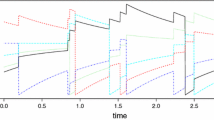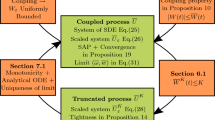Abstract
We consider a new class of non Markovian processes with a countable number of interacting components. At each time unit, each component can take two values, indicating if it has a spike or not at this precise moment. The system evolves as follows. For each component, the probability of having a spike at the next time unit depends on the entire time evolution of the system after the last spike time of the component. This class of systems extends in a non trivial way both the interacting particle systems, which are Markovian (Spitzer in Adv. Math. 5:246–290, 1970) and the stochastic chains with memory of variable length which have finite state space (Rissanen in IEEE Trans. Inf. Theory 29(5):656–664, 1983). These features make it suitable to describe the time evolution of biological neural systems. We construct a stationary version of the process by using a probabilistic tool which is a Kalikow-type decomposition either in random environment or in space-time. This construction implies uniqueness of the stationary process. Finally we consider the case where the interactions between components are given by a critical directed Erdös-Rényi-type random graph with a large but finite number of components. In this framework we obtain an explicit upper-bound for the correlation between successive inter-spike intervals which is compatible with previous empirical findings.
Similar content being viewed by others
References
Berbee, H., Chains with infinite connections: uniqueness and Markov representation. Probab. Theory Relat. Fields 76, 243–253 (1987)
Bollobás, B.: Random Graphs, 2nd edn. Cambridge Studies in Advanced Mathematics, vol. 73. Cambridge University Press, Cambridge (2001)
Brémaud, P., Massoulié, L.: Stability of nonlinear Hawkes processes. Ann. Probab. 24(3), 1563–1588 (1996)
Bressaud, X., Fernández, R., Galves, A.: Decay of correlations for non-Hölderian dynamics. A coupling approach. Elect. J. Prob. 4, 1–19 (1999)
Brillinger, D.: Maximum likelihood analysis of spike trains of interacting nerve cells. Biol. Cybern. 59(3), 189–200 (1988)
Cessac, B.: A discrete time neural network model with spiking neurons: II: Dynamics with noise. J. Math. Biol. 62, 863–900 (2011)
Comets, F., Fernández, R., Ferrari, P.A.: Processes with long memory: regenerative construction and perfect simulation. Ann. Appl. Probab. 12(3), 921–943 (2002)
Doeblin, W., Fortet, R.: Sur les chaînes à liaisons complétes. Bull. Soc. Math. Fr. 65, 132–148 (1937)
Fernández, R., Maillard, G.: Chains with complete connections and one-dimensional Gibbs measures. Electron. J. Probab. 9(6), 145–176 (2004)
Fernández, R., Ferrari, P.A., Galves, A.: Coupling, renewal and perfect simulation of chains of infinite order. Notes for a minicourse given at the Vth Brazilian School of Probability. Manuscript (2001). http://www.univ-rouen.fr/LMRS/Persopage/Fernandez/resucoup.html
Fernández, R., Ferrari, P.A., Garcia, N.L.: Loss network representation of Peierls contours. Ann. Probab. 29(2), 902–937 (2001)
Fernández, R., Ferrari, P.A., Garcia, N.L.: Perfect simulation for interacting point processes, loss networks and Ising models. Stoch. Process. Appl. 102(1), 63–88 (2002)
Ferrari, P.A., Maass, A., Martínez S., Ney, P.: Cesàro mean distribution of group automata starting from measures with summable decay. Ergod. Theory Dyn. Syst. 20(6), 1657–1670 (2000)
Gallo, S.: Chains with unbounded variable length memory: perfect simulation and visible regeneration scheme. Adv. Appl. Probab. 43, 735–759 (2011)
Galves, A., Garcia, N., Löcherbach, E., Orlandi, E.: Kalikow-type decomposition for multicolor infinite range particle systems (2013)
Gerstner, W., Kistler, W.M.: Spiking Neuron Models. Single Neurons, Populations, Plasticity. Cambridge University Press, Cambridge (2002)
Goldberg, J.M., Adrian, H.O., Smith, F.D.: Response of neurons of the superior olivary complex of the cat to acoustic stimuli of long duration. J. Neurophysiol. 27, 706–749 (1964)
Harris, T.E.: On chains of infinite order. Pac. J. Math. 5, 707–724 (1955)
Hawkes, A.G.: Point spectra of some mutually exciting point processes. J. R. Stat. Soc. B 33, 438–443 (1971)
Johansson, A., Öberg, A.: Square summability of variations of g-functions and uniqueness of g-measures. Math. Res. Lett. 10(5–6), 587–601 (2003)
Krumin, M., Reutsky, I., Shoham, S.: Correlation-based analysis and generation of multiple spike trains using Hawkes models with an exogenous input. Front Comput Neurosci. 4, 147 (2010). doi:10.3389/fncom.2010.00147
Møller, J., Rasmussen, J.G.: Perfect simulation of Hawkes processes. Adv. Appl. Probab. 37(3), 629–646 (2005)
Nawrot, M.P., Boucsein, C., Rodriguez-Molina, V., Aertsen, A., Grün, S., Rotter, S.: Serial interval statistics of spontaneous activity in cortical neurons in vivo and in vitro. Neurocomputing 70, 1717–1722 (2007)
Rissanen, J.: A universal data compression system. IEEE Trans. Inf. Theory 29(5), 656–664 (1983)
Spitzer, F.: Interaction of Markov processes. Adv. Math. 5(2), 246–290 (1970)
Acknowledgements
We thank D. Brillinger, B. Cessac, S. Ditlevsen, M. Jara, M. Kelbert, Y. Kohayakawa, C. Landim, R.I. Oliveira, S. Ribeiro, L. Triolo, C. Vargas and N. Vasconcelos for many discussions on Hawkes processes, random graphs and neural nets at the beginning of this project.
This work is part of USP project “Mathematics, computation, language and the brain”, FAPESP project “NeuroMat” (grant 2011/51350-6), USP/COFECUB project “Stochastic systems with interactions of variable range” and CNPq project “Stochastic modeling of the brain activity” (grant 480108/2012-9). A.G. is partially supported by a CNPq fellowship (grant 309501/2011-3), A.G. and E.L. have been partially supported by the MathAmSud project “Stochastic structures of large interacting systems” (grant 009/10). E.L. thanks Numec, USP, for hospitality and support.
Author information
Authors and Affiliations
Corresponding author
Additional information
Dedicated to Errico Presutti, frateddu e mastru.
Rights and permissions
About this article
Cite this article
Galves, A., Löcherbach, E. Infinite Systems of Interacting Chains with Memory of Variable Length—A Stochastic Model for Biological Neural Nets. J Stat Phys 151, 896–921 (2013). https://doi.org/10.1007/s10955-013-0733-9
Received:
Accepted:
Published:
Issue Date:
DOI: https://doi.org/10.1007/s10955-013-0733-9




